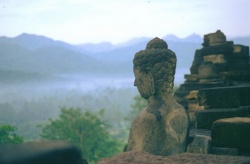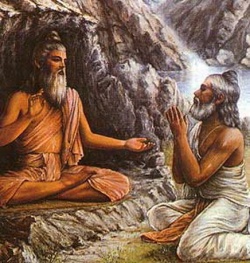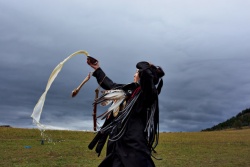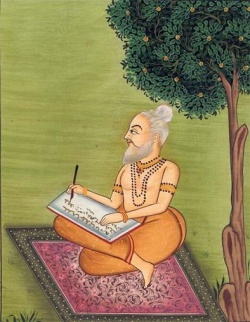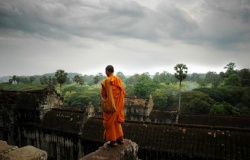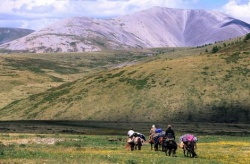Buddhist Linkages between India and Mongolia: Implications for Austral-Asian Region by Dr. Sharad K. Soni
Introduction
The doctrines of Buddhism that originated in India more than 2,500 years ago have once again become the hope of human survival in the current world scenario when we are witnessing both the threats and challenges to the very existence of human race.[1] It is more so because the universal relevance of Buddhism as an organised form of knowledge and spiritual force has the proven record of peaceful co-existence with all religions and the people around the world. While emphasising on this very fact a well-known Sri Lankan-born Buddhist monk and scholar Ven. Dr. K. Sri Dhammananda stated that:
Buddhism is a religion which teaches people to ‘live and let live’. In the history of the world, there is no evidence to show that Buddhists have interfered or done any damage to any other religion in any part of the world for the purpose of introducing their religion. Buddhists do not regard the existence of other religions as a hindrance to worldly progress and peace.[2]
At the moment Buddhism has mass followers (an estimated 300 million) in several countries of the world, whether we talk about countries of Asia or beyond its boundaries to far off regions of Europe, USA and Austral-Asia. For quite some times now India, for that matter, has been witnessing several activities for not only reviving Buddhism on its land from where it was once routed out but also providing a common platform for a united voice of Buddhists worldwide. For example, recently on 27-30 November, 2011, the first Global Buddhist Congregation took place in New Delhi in which more than 900 delegates including heads and representatives from Buddhist Sanghas, national Buddhist federations, organisations and institutions from 46 countries participated. The event was marked by a decision to set up a new international Buddhist organisation in India, which will be called the “International Buddhist Confederation”. Thich Quang Ba, the abbot of Sakyamuni Buddhist Temple at Canberra (Australia) stressed that “The Buddhists all over the world, represented by the delegates at the conference feel the need to develop a common platform that will project a united voice and develop a common response based on the collective wisdom of all Buddhist traditions.”[3] Earlier also, in order to revive an age-old tradition of debates and discussions on various aspects of Buddhism and its relevance in the present day world, a two-day International Buddhist Conclave took place at Nalanda in Bihar (India) on 6-7 February 2010. This conclave, which saw the participation of hundreds of Buddhist scholars, monks and academicians from across the world, has been taking place since 2004.
Such global level Buddhist interactions indeed help understand how Buddhism can positively contribute to the establishment of peace and harmony in the world which in the context of international relations could help develop bilateral and multilateral relations. India has a long tradition of having historical and cultural ties based on Buddhism with numerous countries, particularly those belonging to Asia. One such example is Mongolia with which India has a rich legacy of Buddhist linkages that helped the two countries to develop very close and friendly relations in modern times so much so that they are now known as “spiritual” neighbours. It is in this background that this paper seeks to highlight the Buddhist linkages between India and Mongolia and implications of such linkages in the Austral-Asian Region, that is to say, how Buddhism, in the contemporary world including the Austral-Asian Region, would help develop bilateral and multilateral relations taking the example of India and Mongolia. This would also provide some directions for further development of Buddhism particularly in the specific region of Austral-Asia.
Historical Legacy of India-Mongolia Ties
Though geographically far apart, India and Mongolia are the two ancient civilizations of Asia whose spiritual and cultural bonds go back to history spanning over a period of more than 2,500 years. One can find the reference of India in Mongolian historiography as well, such as Monggol-un Niguca Tobciyan (The Secret History of the Mongols) written probably in 1240 AD, which is the earliest survived Mongolian chronicle. In sections 261 and 264 of this chronicle India is referred to as Hindu (Hindustan) and the river Indus (Sindhu) as Shin-muren.[4] However, what is striking to note here is that it was due to the advent of Buddhism that India was well known in the Mongol land long before the appearance of the Mongols into the historical arena. Buddhism that reached there through [[Wikipedia:Central Asia|Central Asia]] from its original homeland in India played a significant role in the pre-Mongol period in bringing the ancient nomadic tribes or more precisely the barbarian dynasties that ruled the Mongol plateau to get acquainted with the Indian culture. Regardless of their ethnicity these nomadic tribes, such as Xiongnu, also spelled as Hsiung-nu (Hun), Hsien-pi, Tobgatch Turks or Toba Wei, Turks and Uyghurs came under the influence of Buddhism so much so that this religion seems to have made a place for itself at the top level of the then existing society.
Though Asoka was most responsible for the spread of Buddhism in [[Wikipedia:Central Asia|Central Asia]] if not Inner Asia as a whole,[5] it is commonly assumed among the historians of Buddhism that in the first century AD there were three strong cultural spheres, i.e., India, China and Inner Asia, all of which touched upon each other along the trade route running through [[Wikipedia:Central Asia|Central Asia]] into Xinjiang and culminating at Dunhuang, which is known as the gateway to Xinjiang situated along the ancient Silk Road in today’s China’s Gansu province. The Xiongnu Empire (3rd century BC - 1st century AD) extended along the length of the road in Turkestan,[6] at least from Turfan to Dunhuang, and that Buddhism spread simply along this road into China and from that point was then carried into the Mongol plateau. According to Mongolian historical sources, Buddhism was spread not only in southwestern part of Xiongnu state but also in the present territory of Mongolia. The travelogues of Chinese Buddhist monks suggest that during Xiongnu rule both Mahayana and Hinayana (Theravada) schools of Buddhism became firmly established in Mongolia.[7] At that time three-meter tall standing golden Buddha statue was the main object of worship for the inhabitants of southwestern part of that state. This fact is attested by the The History of Wei State which clearly states that the Buddha statue was being worshipped at that time.[8] Hor chos ‘byung by Zava Damdin provides yet another evidence of the existence of a Jowo Buddha temple belonging to the Xiongnu period, which was located in the then Bayanbalgad city along the northern bank of the present Selenge river in the Selenge aimag of Mongolia.
Further, Buddhism was adopted as the State religion not only by the Nirun State (330 AD-550 AD) of the Mongolian origin but also by the Toba Wei state (386 AD-581 AD). The two principal policies which had been formulated and adopted by Emperor Asoka and King Kanishka of India to unify the government and Buddhist administration emerged as a state tradition of Mongolia since the time of Nirun.[9] The deep rooting of Buddhism in Mongolia was further got strengthened between the people of Nirun state and India by the visit of the two Indian Buddhist philosophers Sakyavarasha and Narendrayasa to Mongolia in the 6th century AD. Later on, the Sogdians, the Khotanese and the Uyghurs played an active intermediary role in introducing Buddhism to the Eastern part of [[Wikipedia:Central Asia|Central Asia]], i.e., the area inhabited by the Mongols. The Uyghurs were one of the most advanced nomadic peoples, who established their own powerful kingdom in the Mongol plateau and ruled it during 8th - 9th centuries AD. During this period both Buddhism as well as Manichaean were the primary religions under the state patronage. At that time, the Uyghur script was widely used to translate the Buddhist sutras and scriptures into Mongolian language. It is noteworthy that after having been adapted to the Mongolian language, the Sogdian-Uyghur script that was originated from the Phoenician-Aramaic system of writing, served as a flexible instrument of learning and literature for many centuries to follow.[10]
Yet Buddhism does not appear to have become so important in the political or religious affairs of the Mongol Khans (Qagans) until after the establishment of the Great Mongol Empireunder the leadership of Genghis Khan (1206-1227) in the 13th century AD. This was the beginning of a most spectacular period of Mongols’ contact with Buddhism, particularly the Tibetan form of Buddhism, though the possibility of direct Buddhist contacts between the Mongol land and the northern parts of India, especially Kashmir cannot be ruled out. The Chinese sources Xin Yuan-shi records that during the reign of Ögedei Khan (1229-1241) the Kashmiri Buddhist monk Namo and his brother, Otochi came to the Mongolian court.[11] He also stayed during the reigns of Ögedei Khan’s successors - Güyük Khan (1246-1248) and Mongke Khan (1251-1259). In 1253, Mongke Khan appointed Namo as kuo-shih, the State preceptor or what we know in India as Rajguru. He was given a jade seal to administer Buddhist affairs and was also assigned to head ten thousand Kashmiri households.[12] Simutaneously, a new period began in India-Mongolia contacts when Buddhism received state patronage under the Mongol ruler Khubilai Khan, the founder of the Yuan dynasty in China. Though both the Chinese and Tibetan varieties of Buddhism were accessible to the Mongol Khan, he preferred to go for the latter one.
Having converted himself to Buddhism as far back as in 1242 AD, Khubilai rewarded this religion by placing a Tibetan Buddhist monk the Phags-Pa Lama Lodoijalsan (1235 AD-1280 AD) as the “State Preceptor” (kuo shih).[13] Significantly, from the Phags-Pa Lama he accepted the concept of a ruling duality in which two spheres- the sacred and the secular, operated co-terminously.[14] Although the concept of the dual principle, i.e., ‘priest-patron’ (Choe-Yon) relationship,[15] ended with the downfall of the Yuan, its ideal was preserved in both Mongol and Tibetan literature. The Phags-Pa Lama also developed a new script called Phagspa script based on Nagari system of India. It is to be noted that Tibet, at that time, had truly become a midstream between India and Mongolia, “transmitting to Mongolia all what they had themselves borrowed from Buddhist India since long ago.”[16] By this time the influence of Buddhism on Mongolia was so strong that the two great Mongolian Khans – Chinggis and Khubilai were considered to be reincarnations of Bodhisttavas; Vajrapani and Manjushri. The years that followed witnessed not only an interchange of scholars and monks between Mongols and Tibetans, but also it was the Mongol ruler Altan Khan who gave the title Dalai (meaning “ocean of wisdom”) to the Tibetan lama Sonam Gyatso in 1577. Thus began the lineage of Dalai Lamas of which the present title-holder is the 14th. It has been revealed that the Tibetan schools of Buddhism (Sa-Skya-pa, Karma-pa, and Gelug-pa) passionately continued their missionary work among the Mongols,[17] and by the end of the sixteenth century most of the Mongols were converted to Lamaism.
Another feature of India-Mongolia Buddhist linkages can be seen through the Mongolian script of Soyombo and Quadratic which were invented by Undur Gegen Zanabazar (1636-1723), the first Jebtsundamba Khutagt, to study Buddhism. The very word Soyombo is of Sanskrit origin, i.e., svayambhu which in a more precise term means ‘self-being’ (svayam means ‘self’ and bhu means ‘being’) or ‘freedom’.[18] Though the script died after a while, the first alphabet Soyombo to which the script owes its name became the national symbol of Mongolia signifying its independence and sovereignty.[19] According to Lokesh Chandra, “the Mongolian flag soyombo is the Buddhist svayambhu with its extraordinary array of mystic symbols arranged vertically.” Thus, Buddhism not only helped the hitherto scattered and nomadic Mongols become united and civilized but also enabled the Mongols to learn about various dimensions of Indian philosophy and science as well as applied knowledge such as astrology, poetry, art, medicine, etc. During the nineteenth and early twentieth centuries Buddhism served the Mongols as a prime source of common identity and an effective instrument for whipping up the Mongol nationalism against the Manchu-Qing rule, the collapse of which provided Mongolia an opportunity to declare its independence in 1911. However, Buddhism saw its worst set back during the whole Mongolian history of Soviet dominance until its revival began to take place in the 1990s following the disintegration of the former USSR. In that sense it is not exaggeration to say that Buddhism has once again become one of the most important decisive factors of Mongol identity apart from a unifying factor for Mongols who live in different regions, such as Khalkhas in Mongolia, Buryats in Siberia and Kalmyks at the Volga River. As regards India-Mongolia ties, nothing could deter them even during the seven decades of communist rule in Mongolia; perhaps spiritual bonding between the land of Buddha and the land of blue sky was working in right direction.
Spiritual Neighbours in Modern Times
Sharing a rich legacy of historico-cultural bonds through interaction, assimilation and exchanges due to their being the southern and northern ends of a Buddhist arch, it is but natural that India and Mongolia are now known as “spiritual” neighbours. Now one may ask as to why India is known as Mongolia’s spiritual neighbour.[20] First of all the fact that India is the land of Buddha provides enough reason for the Buddhist Mongolia to call India as its spiritual neighbour. And secondly, the River Ganga is revered as sacred by the Mongolians in the same way as Indians do. For example, in Mongolia, anybody who keeps ‘Gangajal’ (the holy water from River Ganga) at home is considered as the luckiest one. In fact, there is a group of lakes known as ‘Ganga Lake’, which is located in the eastern part of Mongolia, about 12 kms. from Dariganga Sum (county or district), in Sukhbaatar aimag (province). The legend has it that a long time back a man who was a native of Dariganga visited India. While returning back he brought with him holy water from the River Ganga, which he placed in the sand, thus the formation of Ganga Lake took place. This is the only group of lakes, which is located in desert and is considered as sacred by the people of Mongolia. Besides, India is venerated in Mongolia not only as a homeland of Buddha but also as a country to which the Mongolian people attribute all that have been considered the highest attainments of wisdom and learning.[21] That is to say India is seen as such a divine place, where emphasis is given on Buddhist principles of denouncing anger and hatred, violence and rancor, apart from promoting universal peace and harmony through individual attainment of compassion and serenity.[22] The spiritual linkages between India and Mongolia, therefore, make it imperative for the two sides to cooperate each other in areas of mutual concerns.
Ever since the two countries signed the Treaty of Friendly Relations and Cooperation in 1994, a solid foundation was laid down for further development of bilateral relations and cooperation on regional and international relations. However, before dealing with the extent and pattern of cooperation between the two sides in significant areas of bilateral and multilateral importance, it requires to highlight the Buddhist linkages in the post-Soviet period. The one name which needs to be mentioned here is that of the Ven. Kushok Bakula Rimpoche who was instrumental in not only the revival of Buddhism in Mongolia but also in deepening the cultural ties based on Buddhism between the two countries. In 1990, he was appointed as the Indian ambassador to Mongolia which lasted for more than 10 years until he retired in 2000. When he arrived, Mongolia was still a communist country but soon it became a free country, and Bakula Rinpoche could travel freely and work for the revival of Buddhism. He established monasteries and nunneries, hosted His Holiness the Dalai Lamad Lama Zopa Rinpoche several times, and granted ordination to many Mongolians. He was often called “Elchin Bagsha”, the teacher ambassador. On 26 June 2001, the Mongolian President conferred on him “The Polar Star”, the country’s third highest state order that was rarely given to a foreigner, for “strengthening Indo-Mongolian ties and for promoting Buddha Dharma in Mongolia.”[23]
It is worth to be noted here that in Mongolian folktales, there was a lore that Bakula Arhat would one day come from India to revive Buddha Dharma, and indeed he came in the person of Kushok Bakula. Under his guidance, Pethub Monastery (established by him in 1999) and Dechen Ling Nunnery in Ulaanbaatar developed into important centres of learning for the Mongolian Buddhists.[24] During his service as India’s ambassador to Mongolia he encouraged more Mongolian monks to come to India and study at the Institute of Buddhist Dialectics in Dharamsala, at the Drepung Gomang in Mundgod or the Sera Monastery in Bylakuppe in Karnataka, and in other places. Due to his efforts, the number of scholarships for Mongolians to study in India extended from just a few to over 100. In 2005, the late Penor Rinpoche’s Kunzang Palyul Choling, in partnership with the Khamariin Khiid in Sainshand Sum (district) of Dornogovi province of Mongolia, began sponsoring Mongolians to study Buddhism in India at the Namdroling Monastery in Bylakuppe. As of 2011 more than 230 Mongolian student-monks were reported to have been living in Mundgod of India’s Karnataka state.[25] Recently, India has liberalized its visa regime for Mongolian Buddhist monks coming to India for Buddhist Studies. They are now given a straightway 5-year Indian visa. The Buddhist monks were earlier given one year visa and they had to return to their country and come back again with a new entry permit in case the duration of the course was more than 12 months. This Indian initiative has been taken to deepen the centuries old traditional cultural ties and boost bilateral relations between the two countries. This was acknowledged by the Indian President Pratibha Patil at the end of a three-day visit to Mongolia just six-months ago on 30 July 2011. “We have historic relations with each other. There is a strong link of Buddhism. Those monks who come to study here...are very happy. I understand it will give a cordial atmosphere to further our relationship,” said President Patil.[26]
Earlier in January 2004, India and Mongolia also signed an agreement to construct a Mongolian-run Buddhist monastery in sacred place of Bodh Gaya, Bihar (India), where according to Buddhist tradition, Gautama Buddha attained enlightenment. The Bihar government provided a free grant of land on which the monastery was to build. During his visit to India the then Prime Minister of Mongolia Nambaryn Enkhbayar personally laid the foundation stone. In order to reinforce cultural links between the two sides a Chair of Buddhist and Sanskrit Studies in the National University of Mongolia was also established in accordance with the agreement concluded in April 2006 between Government of India and the Ministry of Education, Science & Culture of Mongolia. The two sides are now involved in strengthening exchanges in the field of Buddhism, including Buddhist studies, in order to preserve this common heritage. One fine example is the Indian support to the digitalization of precious Buddhist manuscripts preserved at Mongolian State Library.
Buddhist Linkages as Driving Force for Multilateral Cooperation
India being the “spiritual home” in the eyes of the Mongolians and about 92 per cent of them following Buddhism offer a unique opportunity for both sides to further strengthen their civilizational bonds. India has come a long way from 1955 when it became the first country outside the Soviet bloc to establish diplomatic relations with Mongolia. In the post-Cold War period, Mongolia is considered to be critical for what several analysts describe “a rising India’s Asian strategy”. Such concerns provided an opportunity for the two countries to upgrade their bilateral ties to comprehensive partnership, and Buddhist factor played an important role to do so in 2009. It was, in fact, during the September 2009 visit of Mongolian President Ts. Elbegdorj to India that both sides acknowledged the ongoing state of political relations based on historical and cultural ties, common democratic traditions and a shared desire for regional peace and stability. However, the most important event that took place during this visit was the decision of the two countries to upgrade the level of their bilateral relations to a comprehensive partnership. To this end, both sides formalized their comprehensive partnership by signing a treaty to cooperate in developing Mongolian uranium mining with a MoU on the “peaceful use of radioactive minerals and nuclear energy”.
Further, recognizing the importance of historical, cultural and spiritual links between India and Mongolia, the two sides underlined the need of nurturing these areas through promotion of all round cooperation beyond bilateralism. The 2011 visit of Indian President Pratibha Devisingh Patil to Mongolia witnessed an exchange of views on the ways to broaden the bilateral cooperation as well as on the issues pertaining to cooperation on the regional and multilateral arena.[27] Mongolian President himself stressed on expanding the bilateral traditional relations in cultural, educational and humanitarian fields, besides developing mutually beneficial cooperation in the areas of trade, economy and investment on multilateral basis. As such both countries have also been focusing on their “geostrategic interests.”[28] On its part, Mongolia as a young democracy, cautious of past subordination to Moscow and China’s hunger for natural resources, sees diversifying its international ties as the best guarantee of not only its political and economic independence but also attracting multilateral forces for supporting its presence in various regional cooperation efforts. The other significant point to be highlighted here is that Mongolia’s strategic location as a geographical bridge between [[Wikipedia:Central Asia|Central Asia]] and Northeast Asia could provide an impetus for spreading India’s soft power because having more than one strong ally there could be beneficial to Indian interests in the whole region.
Moreover, India’s traditional South Asian centric security policies are being stretched out into East Asia and the Pacific as well as a northward movement into [[Wikipedia:Central Asia|Central Asia]].[29] But according to Miliate, “with an ever increasing liberal interpretation of regional security it may well be the case that East Asia as a division could expand into South Asia and northward to include Russia and Mongolia, bringing into question the whole issue of geographical divisions in an increasingly transnational world”.[30] In this sense, Mongolia is not only an economic partner but a strategic and a natural partner in India’s “Look East” Policy, which was designed to strengthen its engagement with the Asia-Pacific as a whole. However, it remains to be seen whether Mongolia-India synergy would indeed benefit New Delhi in its engagement with North East Asia to the extent of becoming a major player in this region to make its worthy contribution especially to the regional integration process.[31] Yet, there is a commonality of views between the two countries on several regional and multilateral issues. They are committed to enhance their cooperation on such issues, particularly those related to peace and stability in the Asia-Pacific region, including through enhanced interaction at multilateral forums such as the ASEAN Regional Forum (ARF), the Asia Europe Meeting (ASEM) and East Asia Summit (EAS).
Thanks to the countries like Mongolia that India has been elected to the non-permanent seat of the UN Security Council for 2011-2012. Back home Mongolia’s focus today is on pressing socio-economic issues close at hand. Unemployment, poverty, speedy urbanization and the ensuing social displacement pose potential threats to long-term stability and economic prosperity of the country.[32] Moreover, it becomes even more difficult task in the absence of a meaningful regional cooperation framework. India’s ongoing role at least in East Asia, which includes both the South East Asia as well as North East Asia, may have far reaching consequences to the extent of benefiting Mongolia so far as issue of regional cooperation is concerned. Obviously, Mongolia could seek India’s support and certainly in view of the recent developments in India-Mongolia relations due to the upgradation of bilateral ties to cooperative partnership, it seems possible in all sense. As such India and Mongolia have been maintaining closer bilateral ties to the extent of forging them into multilateral cooperation, notwithstanding the physical barriers. The credit, of course, goes to Buddhist linkages which are also attested by the fact that the people of India living in the Himalayan region have racial, cultural and religious affinity; even their food habits and customs are identical with those of the Mongols.[33] Taking the example of India and Mongolia, Buddhism in the contemporary world including the Austral-Asian region would indeed help develop bilateral and multilateral relations.
Implications for Austral-Asian Region
On the website of Australia’s Buddhism one can find a written quotation: “The Weapons of Mass Destruction are Greed, Anger and a Deluded Mind - Find them and Destroy them Now!”[34] That is what everyone in the world today has the responsibility to do, and notwithstanding a tough task, it can be done through combined efforts at global level in which the Austral-Asian region too has a role to play. In terms of definition, Austral-Asia is a region of Oceania comprising Australia, New Zealand, the island of New Guinea, and neighbouring islands in the Pacific Ocean. Together it forms an enormous area which in recent years saw a significant development of Buddhism; particular mention may be made of Australia. There are now more Buddhists in Australia per capita than anywhere else in the Western world, which is evident from the fact that the number of Australian Buddhists has doubled since 1996. The 2006 Australian Bureau of Statistics revealed that there are 418,800 Buddhist followers in Australia, representing 2.1 per cent of the Australian population.[35] It is Australia’s close geographical proximity with Asia that has had significant influence on the development of Buddhism in the Austral-Asian region as a whole. Perhaps Buddhism is thriving there because it seems compatible with the perceived needs of an increasingly global society.
As the world has entered into the second decade of the 21st century, Buddhism both as a religion and as part of academic study must be seen in the context of achieving the lofty goals of peaceful co-existence, ensuring friendship from generation to generation, and furthering mutual development through cooperation. The basic tenets of Buddhist teaching are straightforward and practical, i.e., nothing is fixed or permanent; actions have consequences; change is possible.[36] In that sense, Buddhism addresses itself to all people irrespective of race, nationality, caste, sexuality, or gender. It teaches practical methods which enable people to realize and use its teachings in order to transform their experience, to be fully responsible for their lives. Indeed, the first Global Buddhist Congregation that took place in New Delhi in November 2011 rightly focussed on how Buddhism in the contemporary world can positively contribute to the establishment of peace and harmony among religions and communities, and minimize environmental degradation and economic disparity through a non-violent, environment friendly and sustainable model of development based on the principles of right to livelihood.
The world to remain in peace requires coordinated efforts to resolve disputes which further need to have bilateral and multilateral cooperation among both the nations as well as individuals. Such cooperation between India and Mongolia is the best example of being in the right direction of coordinated efforts. Other examples can be set between India and Australia, both of them have convergence of political, economic and social interests in connection with the Association of South East Asian Nations (ASEAN),[37] and here again Buddhism can prove to be a major factor so far as bilateral and multilateral cooperation is concerned. For, all the three can rely on the binding force of Buddhism. If Australia, India and ASEAN coordinate their regional policies and diplomacy in evolving a common consensus on growing threats to regional stability, peace and development, it may prove to be beneficial not only for the concerned nations but also for others including the whole Austral-Asian region. The fact that Buddhism forms a common identity can further be seen through the initiatives of the regional framework known as ASEAN plus 6 countries, comprising the 10 ASEAN members plus Australia, China, India, Japan, New Zealand and South Korea, which are now active in promoting various regional cooperation activities including the economic growth in East Asian countries. Buddhism, therefore, must gather sufficient intellectual resources having a regional and international perspective to carry out more studies in order to contribute to the preservation of world peace and development.
Now the question arises as to what meaningful contribution can scholars on Buddhism make in the Austral-Asian region? In this regard, the following points are to be taken into notice:
- (1)There should be enhancement of research on the history of Buddhism in the Austral-Asian region, especially in Australia where it arrived in 1848 with the advent of Chinese immigrants to work in the gold fields.[38] Though the initial Buddhist influence was not in much fervour, it did take root.
- (2)While conducting research, there should also be emphasis on commending the people who have made significant contribution to the development of Buddhism in the Austral-Asian region and their remarkable achievements, particularly in spreading Buddhist teachings.
- (3)Academic exchange of scholars having expertise on different aspects of Buddhism should be conducted with the outside world, apart from organizing Buddhist Academic Conferences, such as “Buddhism and Australia” in order to exchange ideas among the scholars. This will contribute greatly not only to advancement of research on Buddhism but also in creating a network of Buddhist scholars across the world.
- (4)There should be reciprocal visits of scholars through Governmental or non-governmental channels, which includes the academic visits as well as participation in seminars and conferences at universities or research institutes of other countries in order to collect research materials or write academic papers and undertake joint research projects.
- (5)The Buddhist scholars should make an effort to promote the next generation of scholars who are capable of continuing and developing studies on Buddhist culture at bilateral and multilateral levels.
Conclusion
The foregoing discussions indicate that Buddhism forms an important factor in reformulating and rebuilding not only the national identity of the Mongolian people but also bringing them more close to the Indians. On the other side, due to its close historical links based on Buddhism India would always like to see Mongolia prosper through strengthening bilateral and multilateral relations in every area in the spirit of comprehensive partnership. It is more so because the Buddhist linkages between the two countries are fascinating, intense and inseparable; transcending all human activities from language, literature, religion, medicine, and folklore to culture and traditions. This really sets an example relevant to other regions of the world as to how Buddhism in today’s scenario becomes a major factor in keeping the bond of trust between the two or more countries alive and what should further be done to uphold the same. The Austral-Asian region too can be seen in that perspective. And herein comes the need for establishing close relationships between not only various Buddhist traditions and communities but also academics who could share and exchange knowledge and wisdom in order to contribute to further development of Buddhism in any region of the world. What is striking to note here is that Buddhism can also be employed as geopolitical tool in regional and international perspectives to meet the varied challenges facing the world in the 21st century.
Footnotes
[1]. P. Stobdan, “Challenges before Buddhism: The way Ahead”, in Suchandana Chatterjee and Anita Sen Gupta (eds.), Contemporary Buddhism: Comparative Studies on Eurasia and South Asia (Delhi: Shipra Publications, 2011), pp.11-12.
[2]. Ven. K. Sri Dhammananda, “The Buddhist Attitude towards other Religions”, 13 March 2009, http://www.knowbuddhism.info/2009/03/buddhist-attitude-towards-religions.html
[3]. Quoted in “India to host new world Buddhist body,” Times of India (New Delhi), 1 December 2011, p.10.
[4]. See The Secret History of the Mongols, translated by Urgunge Onon (Ulaanbaatar: Bolor Sudar Publishing House, 2005), pp. 130-131; Sh. Bira, “Historiographical Relationship between India and Mongolia”, in R. C. Sharma and others (eds.), Mongolia: Culture, Economy and Politics (New Delhi: Khama Publishers, 1992), p.23.
[5]. Inner Asia, or the interior of the Eurasian landmass, comprises in historical terms the civilizations of [[Wikipedia:Central Asia|Central Asia]], Mongolia, and Tibet, together with neighbouring areas and peoples that in certain periods formed cultural, political, or ethno-linguistic unities with these regions.
[6]. Turkestan was referred to an extensive region of [[Wikipedia:Central Asia|Central Asia]] lies between Siberia in the north and Tibet, India, Afghanistan, and Iran in the south, i.e., comprising present-day Turkmenistan, Uzbekistan, Tajikistan, Kyrgyzstan and the Southern part of Kazakhstan, as well as areas consisting of the Xinjiang Uyghur Autonomous Region of China.
[7]. Rohan L. Jayetilleke, “Buddhist Heritage of Mongolia”, Daily News (Colombo), 16 March 2010.
[8]. D. Tseveendorj (ed.), Mongol Ulsyn Tuukh, vol.1, Ulaanbaatar. 2003.
[9]. Jayetilleke (2010).
[10]. Sh. Bira, “Mongolian-Indian Relationship: Retrospective Look at Buddhism”, in O Nyamdavaa and Gurdeep Singh (eds.), Mongolia and India: Spiritual Neighbours (New Delhi: Himala Publishers, 2000), p.6.
[11]. Ke Shaomin, Xin Yuan-shi, juan 255, Biography 152, “Foreign Countries” 7, “Biography of India”, Taipei, 1969, Kaiming edition, p.484, cited in Sechin Jagchid, “A Retrospective Look at Mongol-India Historical Relations” in R.C. Sharma (ed.), Mongolia: Tryst with Change and Development (Patiala 7 New Delhi: Vision and Venture Publishers, 1997), p.139.
[12]. Ibid.
[13]. For more on Khubilai’s religious policy and his relationship with Phags-Pa Lama, see Sh. Bira, “Qubilai Qa’an and Phags-Pa Bla-ma,” in Reuven Amitai-Preiss and David O. Morgan (eds.), The Mongol Empire and its Legacy (Leiden: Brill, 1999), pp. 240-249.
[14]. While Khubilai himself retained the task of ruling the secular sphere, the position of ruler of the sacred sphere was given to the Phags-Pa Lama. See Larry Williams Moses, The Political Role of Mongol Buddhism (Bloomington: Indiana University, 1977), p.78.
[15]. Sharad K. Soni and Reena Marwah, “Tibet as a factor impacting China studies in India”, Asian Ethnicity, (London), vol. 12, no.3, 2011, p. 288. For more details, also see Sharad K. Soni, “Mongolia and the Mongols: From Mongol Yuan Dynasty to Manchu-Qing Overlordship”, in Ts. Ishdorj (ed.), Essays on Mongol Studies (Ulaanbaatar: IAMS, 2007), p. 152.
[16]. Bira (2000), p.9.
[17]. Agata Bareja-Starzynska and Hanna Havnevik, “A Preliminary Study of Buddhism in Present-Day Mongolia”, in Ole Brunn and Li Narangoa (eds.), Mongols from Country to City: Boundaries, Pastoralism and City Life in the Mongol Lands (Copenhagen: NIAS Press, 2006), p.215.
[18]. Lokesh Chandra, “Soyombo and Svayambhu : Evidence of Ancient Ties between India and Mongolia”, in O Nyamdavaa and Gurdeep Singh (eds.), Mongolia and India: Spiritual Neighbours (New Delhi: Himala Publishers, 2000), p.2.
[19]. Several scholars are of the opinion that the symbol of Soyombo is based on Vedic thoughts. During his period the Mongolian language and literature borrowed heavily from Indo-Tibetan literature including the Vedic philosophy. See Gauri Shankar Gupta, “India and Mongolia”, in K. Warikoo and Sharad K. Soni (eds.), Mongolia in the 21st Century: Society, Culture and International Relations (New Delhi and London: Pentagon, 2010), pp.108-109.
[20]. Sharad K Soni, “India-Mongolia Relations: Implications for Regional Cooperation in North East Asia”, Mongolian & Tibetan Quarterly , vol.18, no.2, 2009, p. 53.
[21]. Vasanta Iyer, “Cultural Perspectives in Modern Mongolia,” in K. Warikoo and Dawa Norbu (eds.), Ethnicity and Politics in [[Wikipedia:Central Asia|Central Asia]] (New Delhi: South Asian Publishers, 1992), p.268.
[22]. Ibid, p.267.
[23]. Amitava Dutta, “The Venerable Kushok Bakula”, Bharat Rakshak Monitor, vol. 6(3), November-December 2003.
[24].“Pethub Stangey Choskhorling Monastery Celebrates 10th Anniversary”, The UB Post, at http://ubpost.mongolnews.mn/index.php?option=com_content&task=view&id=3309&Itemid=45
[25]. “Indian President to Visit Mongolia, Religious Ties to be Strengthened”, Mongolia Briefing, 21 July 2011, http://mongolia-briefing.com/news/2011/07/indian-president-to-visit-mongolia-religious-ties-to-be-strengthened.html
[26]. Ashwini Shrivastava, “India Liberalises Visas for Mongolian Buddhist Scholars”, 30 July 2011, at http://news.outlookindia.com/items.aspx?artid=729507
[27]. The Office of the President of Mongolia, Public Relations and Communications Division, “Remarks of Tsakhia Elbegdorj, President of Mongolia at the Reception in honour of Pratibha Devisingh Patil, President Of India”, 28 July 2011, at http://www.president.mn/eng/newsCenter/viewNews.php?newsId=580
[28]. Ranjan Gupta “India and Mongolia: A Geostrategic Perspective”, Regional Security Issues and Mongolia, no. 6 1999, p.30.
[29]. Brandon Joseph Miliate, India’s Role in Mongolia’s Third Neighbor Policy, SIT Study Abroad: Mongolia, ISP Collection, (2009), p.17.
[30]. Ibid.
[31]. Sharad K. Soni, “The Importance of Mongolia in India’s Engagement with Northeast Asia”, in Sino-Indian Relations: Challenges and Opportunities for 21st Century, edited by Sudhir Kumar Singh, New Delhi: Pentagon Press, 2011, p.295.
[32] . Sharad K Soni, “India’s New Role in East Asia: Implications for Mongolia”, The Mongolian Journal of International Affairs (Ulaanbaatar), no.13, 2006, p.41.
[33]. See O. Nyamdavaa, Mongolia-India Relations (New Delhi: Bhavana Books & Prints, 2003), pp.30-33.
[34]. Australia’s Buddhism, at http://www.buddhismaustralia.org/
[35]. Cristina Roca and Michelle Barker (eds.), Buddhism in Australia: Traditions in Change (New York: Routledge, 2011), p.1.
[36]. See “Buddhist Religion”, at http://www.buddhist-temples.com/buddhist-religion.html
[37]. Ganganath Jha, “Australia as a Factor in India-ASEAN Relations”, in Dennis Rumley and D. Gopal (eds.), Globalisation and Regional Security : India and Australia (Delhi: Shipra Publications, 2007), pp.195 and 205.
[38]. Michelle Spuler, “Characteristics of Buddhism in Australia”, Journal of Contemporary Religion, vol. 15, no. 1, 2000, pp. 34.
Source
Author: Dr. Sharad K. Soni
buddhismandaustralia.com

